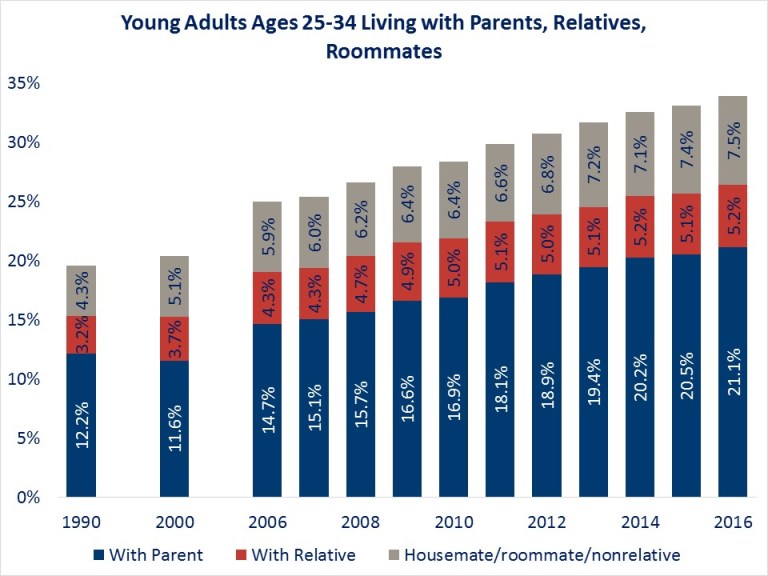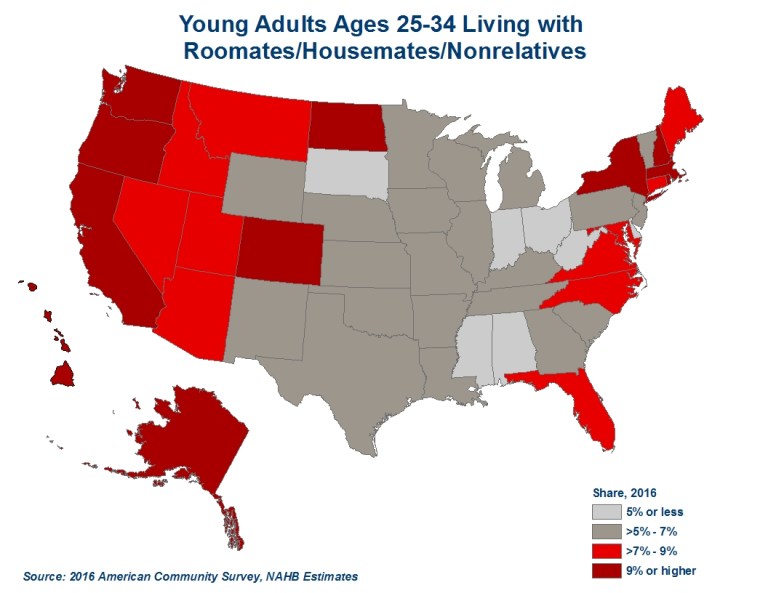Millennials, it is said, are finally moving out on their own, establishing households and buying houses. But, if new research from the National Association of Home Builders (NAHB) is correct, quite a few of them are bucking the trend.
Natalia Siniavskaia writes in NAHB's Eye on Housing blog that sharing living quarters with others is still a hallmark of the generation which is now aged 25 to 34, and its popularity is growing. She says that only 4 percent of those who were in that same age group in 1990 shared living quarters with roommates, housemates, and other non-relatives. By 2016 that number had nearly doubled to 7.5 percent. In addition, 21 percent are still living with parents or in-laws compared to 12 percent 28 years ago, and another 5 percent (versus 3 percent in 1990) are living with relatives other than parents. This means that more than 15 million, or one in three Millennials, is sharing housing with relatives or non-related persons.
The growth in home sharing doesn't appear to be a flash in the pan. After remaining relatively stable at around 15 percent throughout the 1990s, the share of those living with parents or other relatives began to climb, reaching 19 percent by 2006. The growth accelerated during the housing crisis to 26 percent, 21 percent or 9.4 million lived with their parents or in-laws, another 2.3 million bunked with other relatives.

Sharing housing with non-related adults was a trend that grew more slowly, rising from 4 to 5 percent from 1990 to 2000, to 6 percent by 2008 and 7.5 percent in 2016. Still, the number sharing housing with unrelated others, 3.3 million, was an 80 percent increase from the 1.8 million who were doing so in 1990.
States with the largest segments of house sharers includes states with some of the most expensive housing markets, such as California, Hawaii, and New York - where one in ten 25-34-year-olds are sharing their homes and presumably, expensive housing costs with unrelated roommates or housemates. These states also stand out for having some of the lowest headship rates (the share of young adults who are household heads) in the nation.
Conversely, some of the states with the largest percentages of house sharers also have above average headship rates, such as Colorado and Oregon. The transient nature of the District of Columbia means it has the highest share of Millennial-aged house sharers, 20 percent, but, because of its relatively stable job market, the age group also has a high headship rate, 45 percent. The same dichotomy exists in North Dakota, with among the highest incidence of sharers, 9 percent, and 54 percent of Millennials heading their own households.








